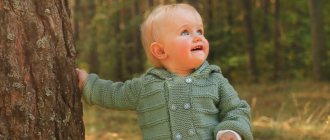One of the most complex physiological and mental processes is the acquisition of speech skills, which occurs differently for each person. It consists not only in developing the ability to pronounce words, but also in understanding their meaning, expressing one’s own emotions, thoughts and desires using the speech apparatus. The development of speech in a child is influenced by the state of health, the environment, and the characteristics of upbringing in the family or educational institution. In this article we will tell you what stages are distinguished in the development of speech in children, what deviations in speech formation there are, and also give simple tips to parents that will help facilitate this process.
Features of speech formation
One of the most important conditions for the development of a child’s personality is the complete and timely acquisition of speech skills. As a rule, these skills begin to develop in childhood and preschool age. Ideally, at the end of the first year of life, the baby should be able to pronounce simple words, and by the age of 3-4 years, his vocabulary should consist of approximately 1000 words.
In theory, at the age of 4 years, a child can already retell a simple fairy tale, describe his actions, and analyze the actions of his parents. However, a different situation is increasingly encountered in practice. That is why pediatricians, child psychologists and speech therapists try to blur clear boundaries, since each child is unique and the process of speech development can proceed in its own way.
For the early development of a child’s speech, it is necessary to create ideal conditions in which the baby:
• physically develops in accordance with age;
• does not suffer from neurological diseases;
• actively communicates with others;
• willingly repeats words spoken by relatives and friends;
• speaks out his desires;
• listens to adult speech;
• tries to pronounce words correctly.
In reality, creating such conditions can be problematic. The reason for this may be mental retardation, previous illnesses, neurological pathologies, or an unfavorable social environment.
In some cases, we can talk about delayed speech development if the child:
• repeats heard words or phrases without much desire;
• does not respond or deliberately clenches his teeth when asked to repeat a spoken word or phrase;
• independently solves everyday problems, deliberately without turning to adults for help;
• pronounces non-existent words;
• does not pay attention to the fact that his speech is incomprehensible to others;
• speaks worse than his peers.
It is believed that girls pronounce their first word before boys. However, they can master phrase speech later, and with age they try to speak in an adult manner. In boys, on the contrary, their grammatical structure is first formed. At the same time, they master adult speech later, replacing it with “their” vocabulary.
What influences speech development?
The following factors influence the development of speech in a child:
1. Auditory attention
. If speech hearing develops rapidly, this usually slows down the development of auditory sensitivity. Meanwhile, the rate of development of phonemic hearing is influenced by musical, in particular, sound-frequency hearing. That is why it is important for parents not only to talk to their baby, but also to sing for them or play music in the background.
2. Motor development
. There is a direct connection between language and motor development. Therefore, in order to speed up the process of forming one, it is necessary to develop the other. Children master speech skills much faster in games that use all the senses and muscles of the body. It is important to ensure that they control muscle movements, especially small ones.
3. Intellectual growth
. If a child utters words or phrases that seem stupid to parents, this should not be assessed as a low level of intelligence. With the help of “their” vocabulary, young children express thoughts, desires, associations, and views on the world. By correcting mistakes, adults thereby prevent the speech apparatus from developing.
4. Emotional development
. The speed of development of speech functions largely depends on the child’s emotional contact with adults. Feeling a connection with his parents, he strives to repeat their words or actions. Children who do not have this contact or who have experienced emotional stress have a much more difficult time speaking early.
5. Communication
. To develop speech, a child must have a desire to communicate with others. After all, speech skills are needed not only to express your emotions and thoughts. It is by communicating with adults that children expand their vocabulary and develop speech functions.
Age stages of speech development
Experts identify several stages of speech development in children. These periods last differently, but every child goes through them.
Preparatory stage (0-1 year)
This period lasts from birth to 1 year. Conventionally, it can be divided into three more stages:
1. Scream
. In the first days and weeks of life, the only way the baby interacts with the outside world is to cry. With its help, he not only notifies of discomfort, but also develops breathing, articulation, and voice.
2. Booming
. Until about 6 months, the baby communicates by pronouncing certain sounds. At this stage, he can be compared to a master tuning a musical instrument.
3. Babbling
. Closer to one year, the child begins to develop full-fledged speech. Instead of incomprehensible sounds, he clearly pronounces “ma”, “pa”, “ba”, “dai”.
Pre-school stage (1-3 years)
At approximately 1 year, when the first words appear in the baby’s vocabulary, the preschool stage of speech formation begins, which lasts approximately up to 3 years.
If at this time he utters any words, they are of a generalized nature. For example, when declaring his desire, asking for something, or begging for a specific item, a baby can say the same word - “give.” Only those closest to him can figure out what exactly he wants.
At about 1.5-2 years old, whole words appear in the child’s vocabulary, from which he can put together short phrases, such as “let me drink,” “mom to drink,” etc. Closer to 3 years, he learns to ask questions “Where?”, “When?”, “Where?”. Some children enrich their speech with prepositions and coordinate words by cases, genders and numbers.
Preschool stage
This stage lasts from 3 to 7 years. It is characterized by the expansion of passive and active vocabulary.
At 4 years old, a child can speak in simple sentences; at 5 years old, he can actively use complex and complex sentences. Closer to 7 years old, he can competently construct sentences, pronounce sounds, and gradually expands his horizons.
What is the norm of speech development
Pediatricians, neurologists, speech therapists, and teachers rely on the norms of speech development when working with children. These include progress in speaking and emotional development characteristic of each individual period of a child’s life. From birth, specialists observe the baby, how he learns to respond to the voice of an adult, reacts to speech from the outside, begins to “walk”, babble and gradually comes to the full process of speaking.
Psychologists warn that it is not worth relying fully on WHO criteria. Each child is an individual, a person with distinctive qualities. One baby can speak at 2 years old, another at 3, and this will be the norm. The main thing is to respond in a timely manner to the delay in speech development, work with the child, and undergo an examination. Often problems lie in the character traits of the baby.
Rules for speech development
Of course, every child is unique.
Therefore, you should not compare him with the neighbor’s baby, who began to walk earlier and uttered his first word before he was a year old.
However, we should also not forget that speech skills are formed, among other things, under the influence of the environment. To raise a fully developed child, parents need to pay attention to speech development. In this case, you must remember the following rules:
1. It's never too early to start
. You need to talk to your child from a very early age. After all, his speech skills begin to form long before he begins to speak meaningfully. They are influenced by touch, smile, intonation and gestures. By supporting nonverbal communication, parents trigger the development of verbal speech.
2. Get rid of eloquence
. In early childhood, when children are just mastering speech, parents should not overload them with a stream of words. It is enough to say one word more than the baby himself says. You can build simple phrases and sentences of 2-3 words. The more accessible speech is, the faster it is mastered. You should not dump on your baby a stream of eloquence, which abounds in mother’s speech. It needs to be simplified so much that the child can not only understand it, but also repeat it.
3. Demonstrate practical application of speech
. The child must learn that speech simplifies everyday life. It is necessary to show the child that the word must be followed by an action. For example, if he is interested in an object, he must ask for it, and his mother gives him this object in response. This will demonstrate the connection between speech and action.
4. Develop fine and gross motor skills
. Every speech therapist assures that speech develops in parallel with the development of fine motor skills. In fact, all-round development is important. A child needs more than just modeling, mosaics or lacing. Speech skills can be learned through dance, music, sports, or even outdoor activities. In addition, gross motor skills contribute to mental and physical development.
5. Sing
. It is easier for a child to master melodic speech. Therefore, when addressing him, chant the words. Ditties, nursery rhymes, and patty games help develop a child’s speech. And here it doesn’t matter at all whether you have hearing or musical education - what’s more important is a smooth and melodious motive.
6. Listen
. It is important not only to talk to the baby, but also to respond to his speech. A mother can spend only one hour a day with her child, entertaining him with games, fairy tales, and reading together. At the same time, her actions will be much more productive than if she spent the whole day with him, without letting go of her smartphone.
7. Fantasize
. Encourage your child's desire to create fairy tales and tell stories. Let their heroes be toys, friends from kindergarten or pets. You can ask him leading questions. For example: “what will happen if our cat learns to fly?”, “what would your toothbrush say if it could talk?” In this case, it is advisable to demonstrate your interest, smile, nod your head. You should not limit your child’s imagination, because this is the only way he will have complete freedom in self-expression.
8. Trust your intuition
. Mom is the person who spends the most time with the child. Therefore, she should be the first to pay attention to existing speech disorders. If you have any doubts, it is better to contact a speech therapist or psychologist once again. However, you should not be paranoid and demand the impossible from your baby.
9. Act consistently
. The main rule when mastering any skill is regularity. It’s better to read 1-2 pages of a fairy tale every day than to burden your child with it for half a day. Exercise a little, but every day. You can alternate between different tools - reading, logic games, mosaics, puzzles. The more the child’s senses are involved in the process, the more harmoniously his speech will develop. And remember that correct and timely development is impossible without an atmosphere of love in the family. Feel free to express your feelings for your baby, his brothers or sisters, and other close people.
Massage of left and right fingers
The massage is done by the mother or speech therapist. Performed by applying light pressure from the fingertips to the wrist. Rubbing from top to bottom. Flexion and extension of fingers.
Very good training of the fine muscles of the fingers is provided by folk games with fingers: “Magpie white-sided”, “Goat”, “Fingers in the forest”, “Finger-boy” and others.
Game “Fingers in the Forest”
The adult holds the child’s hand in front of him and bends the little finger, bends the ring finger, middle finger, index finger and tickles the palm (this finger went into the forest, this finger found a mushroom, this finger washed the mushroom, this finger cooked the mushroom, this finger ate everything, that’s why got fat).
Game “Palm Tree”
The game can be played with several children. Children raise their right hand (or left) with the palm facing them. With the left hand, take the little finger and bend it after the words “wants to sleep”, bend the ring, middle, index, and thumb. They raise their right hand and straighten their fingers at the word “get up” (this finger wants to sleep, this finger went to bed, this finger took a little nap, this finger is already asleep, this finger is fast asleep. Hush, hush! Don’t make noise! The red sun will rise, morning the clear will come, the birds will chirp, the fingers will rise).
Finger gymnastics. The child does it himself
- Plays the piano".
- “Frogs” – simultaneous extension of the fingers.
- Flexion and extension of the fingers one at a time into and out of the fist.
- The fingers greet the thumb of their hand.
- The fingers greet the fingers of the other hand.
- Show me the goat.
- Show me your bunny ears.
- We play the drum.
- Let's clap our hands.
Working with small materials or what you can do to keep your child busy….
- laying out flowers, balls, houses and other mosaic items, millet, rice grains, sticks
- collecting pyramids of various sizes.
- stringing beads onto a rod, removing them one by one
- lacing: use thick cardboard with holes, learn to tie shoelaces
- fastening buttons
- tear the paper into small pieces, first randomly, and then along the folds, along the contour.
Creation
- Applications . We teach the child to work with scissors, hold scissors, cut in straight lines, then along the contour: circles, ovals, squares, triangles and other figures. These figures are cut out of colored paper or painted and made into applications: “Holiday flags”, Collecting apples”, “Flowers”, “We are going to a holiday” (stick on flags, balls, flowers), “Decorate the Christmas tree with toys” (outline is given Christmas trees), “Building a house” (stick squares on the rectangle).
- Drawing. We learn how to hold a pencil, felt-tip pen, and brush correctly. When working with paints, we teach how to carefully apply paint and clean the work area.
To develop active speech, it is necessary to create situations in which the child is forced to address adults with speech.
- Show and name objects, teaching them to use words to find them with their eyes or to bring them.
- Learn to name images in pictures in simplified words: cow – “moo-moo”, dog – “av-aw”, cat – “meow-meow”, etc.
- Gradually displacing onomatopoeia from the child’s speech, teach him to name objects and actions. You need to talk with the child about those objects that attract him at the moment, about the actions that he performs, forming in him a connection between word and object, word and action.
- Arouse speech activity in the child through provoking questions: “Is this a cat?”, and show the dog.
Please note that reading poetry, fairy tales, and nursery rhymes contributes to speech development!
We also remind you that speech formation is influenced not by one specific exercise, but by a daily monotonous set of activities!
At the Medical Center “President-Med” you can sign up for a consultation with a children's speech therapist, have a diagnosis of speech development, get recommendations or take a speech correction course.







